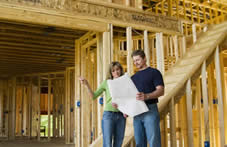In 2008, Maine passed a Statewide Building and Energy Code, which makes building in Maine more straight-forward and saves homebuyers and businesses money on their energy bills from day one. In 2011, Maine's Legislature rolled back Maine's building and energy code. So, while Maine has a statewide code, it is not enforced in many towns.
Maine’s Building and Energy Code: Saving Energy, Assisting Development
 It pays to build buildings right the first time
It pays to build buildings right the first time
Maine people and businesses worry about energy bills, particularly because Maine is dangerously dependent on expensive heating oil and most of our homes and other buildings are older and not efficient. Reaching at least a basic level of energy efficiency is easiest and cheapest in new construction, but, unfortunately, most of Maine’s new buildings are not being built with energy efficiency in mind, and these inefficient buildings will cost us for many decades.
- Building to the Maine code saves money from day one.
- The average Maine homeowner will reap net savings of more than $200/year by building to the energy code instead of following current construction practices. (1)
- The energy code will cut energy Maine costs by more than $25 million over the next 10 years—much, much more if oil prices rise. This is perhaps the most cost-effective way imaginable to reduce Maine’s dependence on oil.
- The uniform, statewide code has broad support from construction industries because it reduces uncertainty and development costs for builders and developers.
- A statewide building and energy code protects homebuyers, who will know their building was built to a minimum standard.
- Maine’s building code law gives towns a high degree of flexibility
- The alternative to a clear, uniform, enforceable code are higher costs for consumers and a confusing regulatory environment for builders.
 Why did Maine pass a building code law in 2008?
Why did Maine pass a building code law in 2008?
The legislation was developed and passed with bipartisan support because:
- Builders and developers were fed up with the patchwork of codes adopted at the municipal level—the situation was confusing, time-consuming, and expensive.
- A detailed study revealed that 85% of new homes being built in Maine would not meet a basic minimum level of energy efficiency. We were locking in higher energy bills for Maine families and businesses for decades to come.(1-A)
- Maine was way behind the times in ensuring adequate, efficient building standards—we were one of only 10 states with no statewide code.
The patchwork, voluntary system wasn't working for builders or consumers. A comprehensive survey of new homes by the Public Utilities Commission in 2008 found that 85% of new homes would not meet Maine’s “model” energy code (a modest, voluntary code—stronger codes are now mandatory in 33 states). One of the primary reasons most homes failed to meet the standard was insufficient insulation.
Building Codes are the Norm
Maine was one of the last states to adopt a statewide building energy code—today 40 states have them. Nearly half the states have adopted the same version of the code as Maine (i.e., the 2009 version).
More Efficient Homes Help Lower Maine’s Global Warming Emissions
- Residential buildings account for more global warming emissions than the commercial or industrial sectors.
- Maine’s Building and Energy Code could save about 100,000 tons of CO2 by 2020.
- The Code is also an important part of Maine’s Climate Action Plan (among the top-ten most cost-effective strategies in the Plan).
Maine’s Common Sense Approach to Codes: Setting the Record Straight
Reasonable, Affordable Standards
- Maine’s building and energy code is based on a consensus code that is used in most states. It is not onerous or expensive to build to and in fact saves building owners money from day one.
- According to actual studies of the cost of building to the code, the incremental costs for a new home may range from $1,000 to 4,000—and, due to the energy savings, homeowners save money starting with their first mortgage payment.
- Assertions of large or prohibitive costs are unfounded.
- The codes don’t have anything to do with a home’s style and allow for a wide range of materials – from logs or straw bales to brick or traditional framing.
- Maine’s version of the code has been adjusted, to meet Maine-specific issues, by a stakeholder board that includes home builders and others. (For example, it does not require residential sprinklers, and allows for locally cut, “unstamped” lumber.)
Implementation
- The Legislature passed the statewide code in 2008 with bipartisan support. In 2009, Maine established a stakeholder Code Board to shape the code to Maine’s needs.
- Towns with more than 4,000 people had until July, 2012 before they needed to begin to enforce the code (see below).
- Towns with less than 2,000 people—more than 350 towns—never have to do any enforcement.
- Builders and contractors know their trade and many are already familiar with these codes. Some builders will need to brush up on techniques, but improvements needed (such as foundation insulation) are not complex. Adjusting to some changes in practice can be unsettling, but it doesn’t make those changes bad and the code only requires widely accepted, well-established practices.
Enforcement Flexibility, Significant Training
- Maine’s code law provides more flexibility for municipal enforcement than any other state.
- In addition to exempting 350 towns with small populations, the law allows towns to forgo direct enforcement and allow builders to hire certified third-party inspectors to confirm that buildings are built to code. Towns may also use traditional Code Enforcement Officers (CEOs), at their discretion.
- A form of third-party certification was already in place for commercial buildings, which must have an engineering stamp on their plans.
- Most existing CEOs have been trained in the code—however they have a year-long grace period to become certified.
- There shouldn’t be any shortage of code officials and inspectors.
1 A) “Maine Residential New Construction Technical Baseline Study,” Vermont Energy Investment Corp for the Maine Public Utilities Commission, 2008. and B) “Incremental Construction Cost Analysis for New Homes: Building to the 2009 IECC,” Building Codes Assistance Project, 2010.









